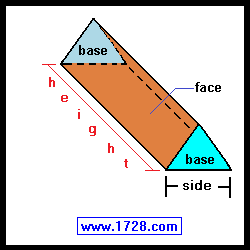|
Right Regular Prism Calculator
for Prisms With Any Number of Sides
Scroll down for instructions and definitions
|
| |
If some of the terminology used in this calculator seems unfamiliar to you, please
read the section below or go to the
regular polygon calculator.
Right Regular Prisms
Most people think of a prism as a 3-sided object
such as the one pictured here.
 This happens to be a right regular prism - a solid geometric figure
whose bases are
parallel regular polygons
and whose faces are all
rectangles perpendicular to the bases. (Since
the rectangles are perpendicular to the regular polygon bases, you can see why these are called
right, regular prisms).
This happens to be a right regular prism - a solid geometric figure
whose bases are
parallel regular polygons
and whose faces are all
rectangles perpendicular to the bases. (Since
the rectangles are perpendicular to the regular polygon bases, you can see why these are called
right, regular prisms).
Specifically, the diagram above is a triangular
right regular prism because its 2 bases are 3-sided regular polygons (or triangles).
There are also square right regular prisms, pentagonal
(pictured below), hexagonal, heptagonal and so on.

Basically, we can think of a right regular prism as a regular polygon that has been extended 90
degrees into a third dimension - height. In the above diagram, the yellow area is one of the two
bases, and the
rectangle formed by the 'height edge' and 'side edge' is one of the five faces.
Prism Area = (Height • Width • Number of Sides) + (Area of Both Bases)
Prism Volume = Area of Base • Height
The default setting is for 5 significant figures but you can change that
by inputting another number in the box above.
Answers are displayed in scientific notation and for easier readability, numbers between
.001 and 1,000 will be displayed in standard format (with the same number of
significant figures.)
The answers should display properly but there are a few browsers that will show
no output whatsoever. If so, enter a zero
in the box above. This eliminates all formatting but it is better than seeing no
output at all.
_____________________
Return To Home Page
Copyright © 1999 -
1728 Software Systems
|

